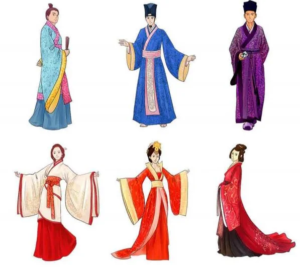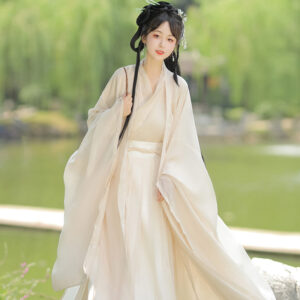

The evolution of Hanfu during the Tang Dynasty (618-907 AD) marked a significant transformation in Chinese clothing, reflecting the cultural richness and cosmopolitan nature of the era. This period is often regarded as a golden age for both fashion and art, characterized by vibrant colors, intricate designs, and the incorporation of diverse cultural elements. The Hanfu of the Tang Dynasty not only showcased advancements in textile technology but also mirrored societal changes and the increasing visibility of women in public life.
| Aspect | Details |
|---|---|
| Time Frame | Tang Dynasty (618-907 AD) |
| Cultural Influence | Open to foreign influences via the Silk Road, leading to diverse styles and fabrics. |
| Fashion Characteristics | Vibrant colors, voluminous styles, intricate patterns featuring natural and exotic motifs. |
| Social Changes | Increased visibility of women led to practical and varied styles in women’s clothing. |
| Technological Advances | Introduction of new fabrics and dyeing techniques expanded the range of available materials. |
Historical Context of the Tang Dynasty
The Tang Dynasty is renowned for its political stability, economic prosperity, and cultural flourishing. It began when Emperor Gaozu seized the throne, ushering in an era characterized by territorial expansion and a robust bureaucracy. The dynasty’s governance model emphasized meritocracy through an imperial examination system, allowing talented individuals to rise in ranks regardless of their social background.This openness to foreign cultures significantly influenced various aspects of Tang society, including fashion. The Silk Road facilitated cultural exchanges that introduced new ideas, customs, and clothing styles from Central Asia, Persia, and beyond. As a result, Hanfu evolved into a more diverse and vibrant expression of identity.
Early Tang Hanfu: Simplicity to Complexity
Initially, Hanfu designs during the early Tang period were relatively simple compared to later developments. The garments typically featured straight lines and modest cuts. However, as the dynasty progressed, fashion became more elaborate:
- Materials: Silk remained the primary fabric for Hanfu; however, cotton and wool began to be integrated into everyday wear due to their accessibility.
- Designs: Early designs were functional but gradually evolved into more intricate forms with added embellishments.
Mid-Tang Evolution: Flourishing Fabrics and Patterns
The mid-Tang period marked a significant turning point in the evolution of Hanfu:
- Introduction of New Fabrics: Weavers began experimenting with blends of silk, cotton, and wool. This diversification allowed for a broader range of textures and styles that catered to different social classes.
- Rich Color Palette: Advancements in dyeing techniques led to vibrant hues that were previously unattainable. Poets from this era often celebrated these colors in their works, highlighting how they reflected the beauty of nature.
- Intricate Patterns: Patterns became more complex during this period. Common motifs included flowers, birds, and other natural elements that resonated with Chinese cultural symbolism.
Late Tang Dynasty: Cultural Synthesis
By the late Tang Dynasty, Hanfu had become a canvas for cultural synthesis:
- Incorporation of Exotic Motifs: Influences from Central Asia became more pronounced as trade routes expanded. New designs featured exotic animals such as lions and peacocks—symbols not traditionally found in Chinese iconography.
- Buddhist and Taoist Symbols: The spiritual landscape of China during this time also influenced clothing design. Many garments incorporated symbols from Buddhism and Taoism, reflecting their significance in daily life.
Social Changes Reflected in Hanfu
The increasing visibility of women during the Tang Dynasty led to notable changes in women’s Hanfu:
- Practical Styles: As women began participating more actively in social life, their clothing adapted accordingly. Skirts became shorter while jackets were tailored for ease of movement.
- Relaxation of Dress Codes: The rigid dress codes that defined earlier periods started to loosen. Commoners began adopting styles that were previously exclusive to nobility.
Influence on Poetry and Art
The evolution of Hanfu during the Tang Dynasty was not only reflected in clothing but also echoed through poetry and art:
- Poetic Celebrations: Poets like Li Bai portrayed Hanfu as symbols of elegance and nobility. Their verses often described specific styles like the “Pao,” a long-sleeved robe that epitomized grace.
- Artistic Representations: Artistic depictions from this period frequently showcased figures adorned in elaborate Hanfu, emphasizing opulence through rich colors and intricate designs.
Comparative Analysis: Hanfu Across Dynasties
A comparison between Hanfu styles across different dynasties highlights significant shifts:
| Aspect | Tang Dynasty | Song Dynasty |
|---|---|---|
| Style | Opulent and diverse | Subdued and refined |
| Color | Vibrant colors | Muted hues |
| Fabric | Silk with cotton/wool blends | Lighter materials |
| Symbolism | Wealth and cosmopolitanism | Humility and tradition |
Conclusion: A Lasting Legacy
The evolution of Hanfu during the Tang Dynasty reflects broader cultural dynamics that shaped Chinese society at the time. From its early simplicity to its later opulence, Hanfu served as a mirror for social changes, technological advancements, and cultural exchanges that characterized this remarkable era. As we explore this rich history further, it becomes evident that Hanfu is not merely a garment but a profound expression of identity interwoven with China’s artistic heritage.
Share this post
Recent Posts


What were the key features of Hanfu during the Tang Dynasty?

How did Hanfu styles vary during different Chinese dynasties?

What accessories are typically worn with Hanfu?

How do you choose the right Hanfu for different seasons?

Newsletter
Popular Categories
Related Post
Sed aliquam, tortor et sodales malesuada, lorem leo luctus tellus, quis interdum eros nibh in nunc. Cras dignissim malesuada, lorem leo luctus

What are the winter hanfu called?

What were the key features of Hanfu during the Tang Dynasty?

How did Hanfu styles vary during different Chinese dynasties?


